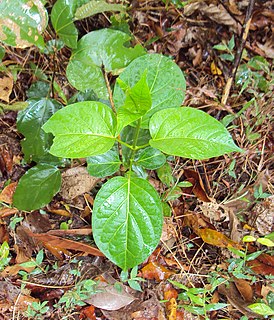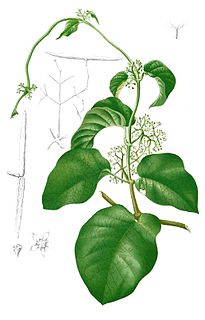
Olea is a genus of about 40 species in the family Oleaceae, native to warm temperate and tropical regions of the Middle East, southern Europe, Africa, southern Asia, and Australasia. They are evergreen trees and shrubs, with small, opposite, entire leaves. The fruit is a drupe. Leaves of Olea contain trichosclereids.

The Indian tent turtle is a species of turtle in the family Geoemydidae. The species is endemic to India and Bangladesh.

Robert Wight MD FRS FLS was a Scottish surgeon in the East India Company, whose professional career was spent entirely in southern India, where his greatest achievements were in botany – as an economic botanist and leading taxonomist in south India. He contributed to the introduction of American cotton. As a taxonomist he described 110 new genera and 1267 new species of flowering plants. He employed Indian botanical artists to illustrate a large number of plants collected by himself and Indian collectors he trained. Some of these illustrations were published William Hooker in Britain, but from 1838 published a series of illustrated works in Madras including the uncoloured, six-volume Icones Plantarum Indiae Orientalis (1838–53) and two hand-coloured, two-volume works, the Illustrations of Indian Botany (1838–50) and Spicilegium Neilgherrense (1845–51). By the time he retired from India in 1853 he had published 2464 illustrations of Indian plants.

The crested kingfisher is a very large kingfisher that is native to parts of southern Asia, stretching eastwards from the Indian Subcontinent towards Japan. It forms a species complex with the other three Megaceryle species.

Millettia is a genus of legume in the Fabaceae family. It consists of about 150 species, which are distributed in the tropical and subtropical regions of the world.

Anodendron is a genus of plant in family Apocynaceae first described as a genus in 1844. It is native to China, the Indian Subcontinent, Southeast Asia, New Guinea, and some islands of the western Pacific.
- Anodendron affine(Hook. & Arn.) Druce - China, Japan, Ryukyu Islands, Philippines, Vietnam, Laos, Thailand, Myanmar, Bangladesh
- Anodendron axillareMerr. - Philippines, Borneo, W Malaysia, Java, Sumatra
- Anodendron benthamianumHemsl. - Taiwan
- Anodendron borneense(King & Gamble) D.J.Middleton - Borneo, Palawan
- Anodendron candolleanumWight - Thailand, W Malaysia, Borneo, Java, Sumatra, Philippines
- Anodendron coriaceum(Blume) Miq. - Thailand, W Malaysia, Borneo, Java, Bali, Lombok, Timor, Flores
- Anodendron gracile(King & Gamble) D.J.Middleton - Borneo, Palawan, W Malaysia
- Anodendron howiiTsiang - Guangxi, Hainan
- Anodendron nervosumKerr - Yunnan, Assam, Laos, Thailand, Vietnam, Java, Sumatra
- Anodendron oblongifoliumHemsl. - Borneo, Philippines, Maluku, New Guinea, Bismarck Archipelago, Solomon Islands, Vanuatu
- Anodendron paniculatum(Roxb.) A.DC. - India, Bangladesh, Sri Lanka, Andaman & Nicobar Is, Malaysia, Indonesia, Philippines
- Anodendron pauciflorumHook.f - Borneo, W Malaysia, Sumatra
- Anodendron punctatumTsiang - Cambodia, Thailand, Guangxi, Hainan, Sichuan
- Anodendron seramenseD.J.Middleton - Maluku
- Anodendron tubulosum(Ridl. ex Burkill & M.R.Hend.) D.J.Middleton - W Malaysia, Sumatra
- Anodendron whitmoreiD.J.Middleton - Maluku, New Guinea, Solomon Islands
- Anodendron wrayiKing & Gamble - W Malaysia
Belostemma is a genus of plant in family Asclepiadaceae, first described as a genus in 1834. It is native to China, India, and Nepal.
- Belostemma cordifolium(Link, Klotz. & Otto) P.T.Li - S China
- Belostemma hirsutumWall. ex Wight - Sichuan, Yunnan, India, Nepal
- Belostemma yunnanenseTsiang - Yunnan
Utricularia scandens is a small, probably annual carnivorous plant that belongs to the genus Utricularia. It has a wide native distribution that includes Africa and Asia. U. scandens grows as a terrestrial plant in wet grasslands and bogs at lower altitudes around sea level up to 2,300 m (7,546 ft). It was originally described by Ludwig Benjamin in 1847. There is a significant amount of synonymy established for this species, in part because of its large distribution and variable morphology.
Cyathocline is a genus of flowering plants in the daisy family.
- Cyathocline jacquemontiiGagnep. - India
- Cyathocline luteaLaw ex Wight - India
- Cyathocline manilalianaC.P.Raju & R.R.V.Raju - India
- Cyathocline purpurea(Buch.-Ham. ex D.Don) Kuntze - China, Indochina, Bangladesh, Bhutan, India, Nepal

Molineria is a genus of flowering plants. In the APG III classification system, it is placed in the family Hypoxidaceae. It is native to Southeast Asia, China, the Indian Subcontinent, Papuasia, and Queensland.
- Molineria capitulata(Lour.) Herb. - China, Indian Subcontinent, Southeast Asia, Papuasia, Queensland; naturalized in Mexico, Central America, West Indies, Argentina, Mauritius, Réunion
- Molineria crassifoliaBaker - Nepal, Assam, Bhutan, Sikkim, Yunnan, Arunachal Pradesh
- Molineria gracilisKurz - southern China, Assam, Bhutan, Nepal, Cambodia, Thailand, Vietnam
- Molineria latifolia(Dryand. ex W.T.Aiton) Herb. ex Kurz - China, Bangladesh, Indochina, Philippines, western Indonesia
- Molineria oliganthaC.E.C.Fisch. - Assam
- Molineria prainianaDeb - Assam, Bhutan
- Molineria trichocarpa(Wight) N.P.Balakr. - southern India, Sri Lanka

Hemidesmus is a genus of plants in the Apocynaceae, first described in 1810. It is native to the Indian Subcontinent.
- Hemidesmus cordatus(Poir.) Schult. - India
- Hemidesmus indicus(L.) R. Br. ex Schult. - Pakistan, India, Bangladesh
- Hemidesmus indicus var. pubescensHook.f., syn of Finlaysonia wallichii(Wight) Venter
- Hemidesmus pubescensWight & Arn., syn of Finlaysonia wallichii(Wight) Venter
- Hemidesmus wallichiiWight, syn of Finlaysonia wallichii(Wight) Venter
Anisochilus is a genus in the Lamiaceae, first described in 1830. It is native to China, the Indian Subcontinent, and Indochina.
- Anisochilus adenanthusDalzell & A.Gibson - southern India
- Anisochilus argenteusGamble - southern India
- Anisochilus cambodianusMurata - Thailand, Cambodia
- Anisochilus carnosus(L.f.) Wall. - India, Sri Lanka, Nepal, Himalayas, Bhutan, Assam, Myanmar, Thailand
- Anisochilus dysophylloidesBenth. - Shervarayan Hills in Tamil Nadu
- Anisochilus harmandiiDoan ex Suddee & A.J.Paton - Thailand, Laos, Cambodia
- Anisochilus mitisR.A.Clement - eastern Himalayas
- Anisochilus pallidusWall. - Yunnan, India, Assam, Bangladesh, Laos, Myanmar, Thailand, Vietnam
- Anisochilus paniculatusBenth. - southern India
- Anisochilus plantagineusHook.f. - southern India
- Anisochilus polystachysBenth. - Nepal, Bhutan, Assam, Bangladesh, eastern Himalayas
- Anisochilus robustusHook.f. - southern India
- Anisochilus scaberBenth. - southern India
- Anisochilus siamensisRidl. - Thailand
- Anisochilus suffruticosusWight - southern India
- Anisochilus velutinusTrimen - Sri Lanka
- Anisochilus wightiiHook.f. - southern India

Secamonoideae is a subfamily of the dogbane family, Apocynaceae.

Cosmostigma is a genus of plants in the Apocynaceae, first described as a genus in 1834. It is native to tropical and subtropical Asia.
- Cosmostigma cordatum(Poir.) M.R.Almeida - India, Sri Lanka
- Cosmostigma hainanenseTsiang - Hainan Province in China
- Cosmostigma philippinenseSchltr. - Philippines
Toxocarpus is a genus of plants in the Milkweed family, Apocynaceae. It is native to China, the Himalayas, and Southeast Asia.

Heterostemma is a genus of plants in the Apocynaceae, first described in 1834. It is native to India, China, Southeast Asia, Australia, and certain islands in the Pacific.

Orthanthera is a genus of plants in family Apocynaceae, first described as a genus in 1834. It is native to India and Africa.
- Orthanthera albidaSchinz - Namibia
- Orthanthera butayei(De Wild.) Werderm. - Zaire
- Orthanthera gossweileriC.Norman - Angola
- Orthanthera jasminiflora(Decne.) N.E.Br. ex Schinz - South Africa
- Orthanthera strictaHiern - Angola
- Orthanthera vimineaWight - Uttar Pradesh in India
Pentasachme is a species of plants in the Apocynaceae first described as a genus in 1834. It contains only one recognized species, Pentasachme caudatum, native to southern China, the Indian Subcontinent, and Southeast Asia.

Streptocaulon is a genus of plants in the Apocynaceae, first described as a genus in 1834. It is native to India, China and Southeast Asia.

Holigarna is a genus of trees in the subfamily Anacardioideae of the cashew and sumac family Anacardiaceae. They grow naturally in India, Bangladesh and Indo-China. This is a poisonous tree if contacted it would irritate skin chemically and result in irreversible skin damage. Smoke from burning this wood is dangerously disabling.
















